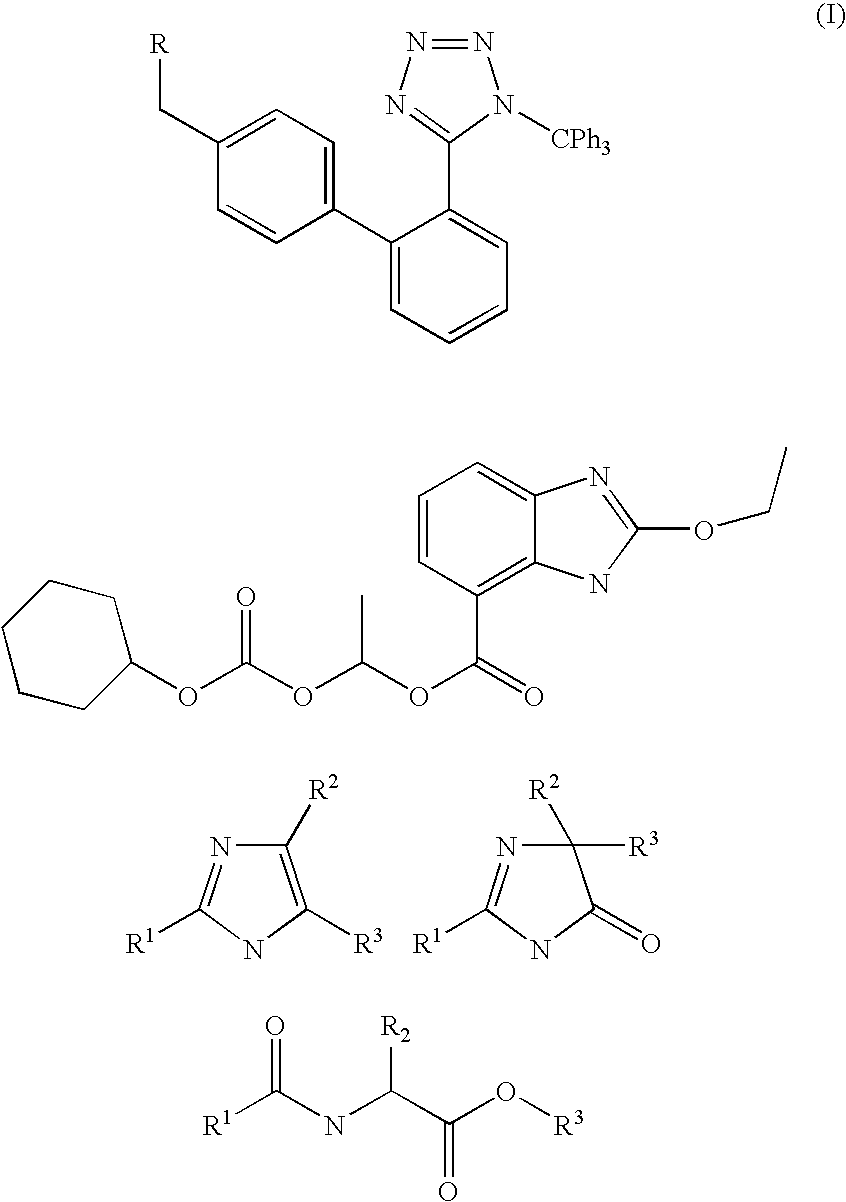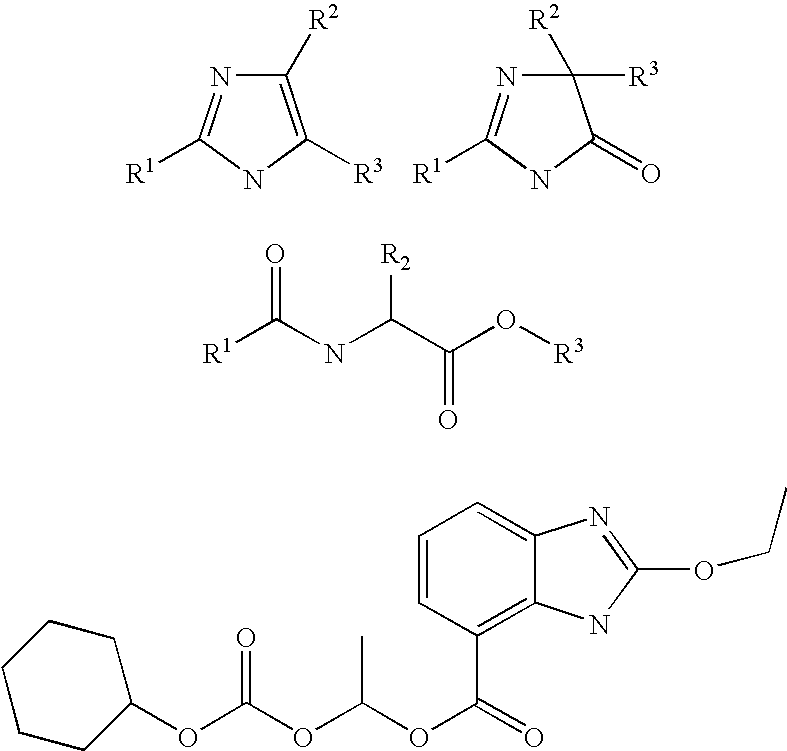Method of removing the triphenylmethane protecting group
a technology of protecting group and triphenylmethane, which is applied in the field of removing the protecting group of triphenylmethane (trityl), can solve the problems of long azeotropic distillation, difficult to remove excesses, and complicated removal of excesses, and achieves the effect of easy solubl
- Summary
- Abstract
- Description
- Claims
- Application Information
AI Technical Summary
Benefits of technology
Problems solved by technology
Method used
Image
Examples
example 1
2-Butyl-4-chloro-1-[[(2′-tetrazol-5-yl)-1,1′-biphenyl-4-yl]methyl]-5-hydroxymethyl-imidazole
[0029] A suspension of 10 g (0.015 mol) of 2-butyl-4-chloro-1-[[(2′-1-trityl-1H-tetrazol-5-yl)-1,1-biphenyl-4-yl]methyl]-5-hydroxymethyl-imidazole (trityl losartan, IV) in 50 ml of anhydrous methanol was refluxed for 7 hours. The solution was then cooled to −10° C. and stirred at this temperature overnight, the precipitated crystals were sucked off and washed with a small amount of ice-cold methanol. 3.7 g (90%) of methyltriphenylmethyl ether (XIII) were obtained. The combined mother liquors were evaporated and boiled with 50 ml of hexane, the mixture was cooled and the insoluble part was sucked off, stirred at room temperature with 50 ml of cyclohexane for 10 hr, the insoluble part was sucked off. 6.2 g of the product (98%) were obtained with mp of 186-188° C. 1H NMR spectra (DMSO): 0.81 t, J=7.24, 3H; 1.27 m, 2H; 1.47 m, 2H; 2.47 t, J=7.57, 2H; 4.35 s, 2H; 5.26 s, 2H; 7.03-7.12 m, 4H; 7.49...
example 2
Potassium salt of 2-butyl-4-chloro-1-[(2′-tetrazol-5-yl)-1,1′-biphenyl-4-yl]-5-(hydroxymethyl)-imidazole (losartan, III)
[0030] A suspension of 10 g (0.015 mol) of 2-butyl-4-chloro-1-[(2′-1-trityl-1H-tetrazol-5-yl)-1,1-biphenyl-4-yl]-5-(hydroxymethyl)-imidazole (trityl losartan, IV) in 100 ml of anhydrous methanol was refluxed for 7 hr. The solution was then concentrated to ca ⅕ of its volume and the after-cooling-precipitated methyltriphenylmethyl ether (XIII) was sucked off and washed with a small amount of ice-cold methanol. 3.71 g (90%) of methyltriphenylmethyl ether (XIII) were obtained. The filtrate was evaporated and the evaporation residue was dissolved in 100 ml of methanol. 1.50 g of KHCO3 was added and the mixture was refluxed for 4 hr. Methanol was then evaporated and after acetone was added the evaporation residue crystallized. The crystals were sucked off and washed with a small amount of ice-cold acetone. 5.29 g (76.5%) of the potassium salt of 2-butyl-4-chloro-1-[(2...
example 3
Potassium salt of 2-butyl-4-chloro-1-[(2′-tetrazol-5-yl)-biphenyl-4-yl]-5-(hydroxymethyl) -imidazole (losartan, II)
[0031] 2.10 g of calcined potassium carbonate (0.0150 mol) was added to a suspension of 10 g (0.0150 mol) of 2-butyl-4-chloro-1-[(2′-1-trityl-1H-tetrazol-5-yl)-1,1′-biphenyl-4-yl]-5-(hydroxymethyl)-imidazole (trityl losartan, IV) in 65 ml of anhydrous methanol and the mixture was brought to the reflux. The mixture was, after 6 hr of reflux, stirred overnight without heating. The next day the solution was concentrated to ⅓ of its volume and the after-cooling-precipitated methyltriphenylmethyl ether (XIII) was sucked off. The filtrate was evaporated and the evaporation residue crystallized after adding acetone. The crystals were sucked off and washed with a small amount of ice-cold acetone. 4.98 g (72.0%) of the potassium salt of 2-butyl-4-chloro-1-[(2′-triphenylmethyltetrazol-5-yl)-1,1′-biphenyl-4-yl]-5-(hydroxymethyl)imidazole (III) were obtained. Mp (DSC) 233.9° C. (...
PUM
| Property | Measurement | Unit |
|---|---|---|
| temperatures | aaaaa | aaaaa |
| temperature | aaaaa | aaaaa |
| blood pressure | aaaaa | aaaaa |
Abstract
Description
Claims
Application Information
 Login to View More
Login to View More - R&D
- Intellectual Property
- Life Sciences
- Materials
- Tech Scout
- Unparalleled Data Quality
- Higher Quality Content
- 60% Fewer Hallucinations
Browse by: Latest US Patents, China's latest patents, Technical Efficacy Thesaurus, Application Domain, Technology Topic, Popular Technical Reports.
© 2025 PatSnap. All rights reserved.Legal|Privacy policy|Modern Slavery Act Transparency Statement|Sitemap|About US| Contact US: help@patsnap.com



